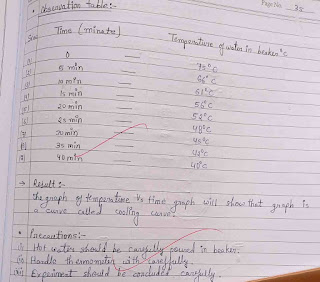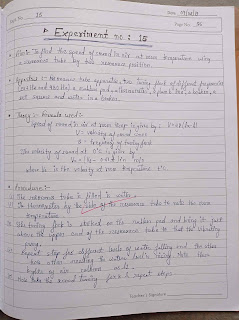| Experiments: Section A 1. To measure diameter of a small spherical/cylindrical body and to measure internal diameter and depth of a given beaker/calorimeter using Vernier Callipers and hence find its volume. 2. To measure diameter of a given wire and thickness of a given sheet using screw gauge. 3. To determine the radius of curvature of a given spherical surface by a spherometer. 4. To find the weight of a given body using the parallelogram law of vectors. Experiments: SECTION–B 5. To find the force constant of a helical spring by plotting a graph between load and extension. 6. To determine the coefficient of viscosity of a given viscous liquid by measuring terminal velocity of a given spherical body. 7. To study the relationship between the temperature of a hot body and time by plotting a cooling curve. 8.To find the speed of sound in air at room temperature using a resonance tube by two resonance positions. Activities: Section A 1. To make a paper scale of given least count, e.g., 0.2cm, 0.5 cm. 2. To determine mass of a given body using a metre scale by principle of moments. 3. To plot a graph for a given set of data, with proper choice of scales and error bars Activities: Section B 4. To observe change of state and plot a cooling curve for molten wax. 5. To observe and explain the effect of heating on a bi-metallic strip. 6. To study the factors affecting the rate of loss of heat of a liquid. Evaluation Scheme: Each student has to perform two experiments and one activity: Experiment 1: 7marks Experiment 2: 7 marks Activity: 3 marks Project file: 3 marks Record notebook: 5 marks Viva: 5 marks Total: 30 marks Experiments of Section A 1. To measure diameter of a small cylindrical body using Vernier Calipers. To measure internal diameter and depth of a given beaker using Vernier Calipers and hence find its volume. To measure internal diameter and depth of a given beaker using Vernier Calipers and hence find its volume. |
| 2. To measure diameter of a given wire and thickness of a given sheet using using screw gauge. |
| 3. To determine radius of curvature of a given spherical surface by a spherometer. |
| 4. To study the relationship between force of limiting friction and normal reaction and to find the co- efficient of friction between a block and a horizontal surface. 2. To determine mass of a given body using a metre scale by principle of moments. 3. To plot a graph for a given set of data, with proper choice of scales and error bars. Experiments of Section B 1. To find the force constant of a helical spring by plotting a graph between load and extension. 2. To determine the coefficient of viscosity of a given viscous liquid by measuring terminal velocity of a given spherical body. 3. To study the relationship between the temperature of a hot body and time by plotting a cooling curve. 4. To find the speed of sound in air at room temperature using a resonance tube by two resonance positions. Activities of Section B 1. To observe and explain the effect of heating on a bi-metallic strip. 2. To note the change in level of liquid in a container on heating and interpret the observations. 3. To study the factors affecting the rate of loss of heat of a liquid. |
Labels
XI
Labels:
XI











































Comments
Post a Comment